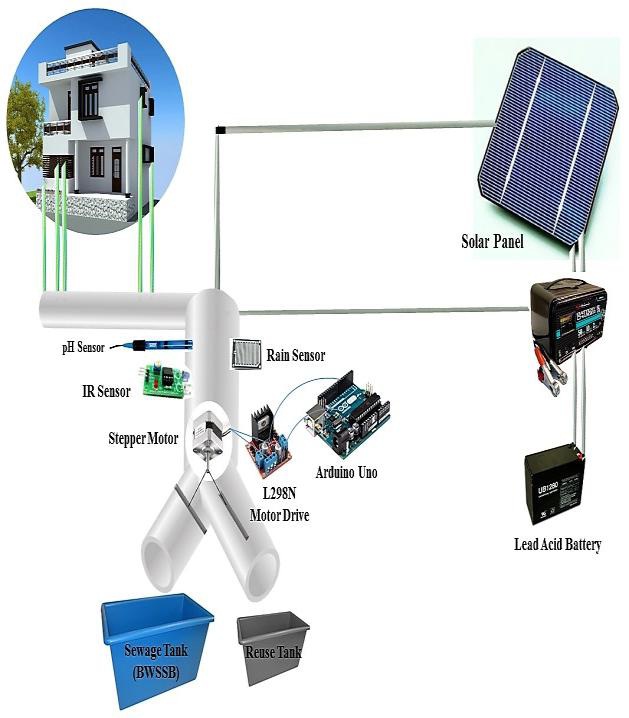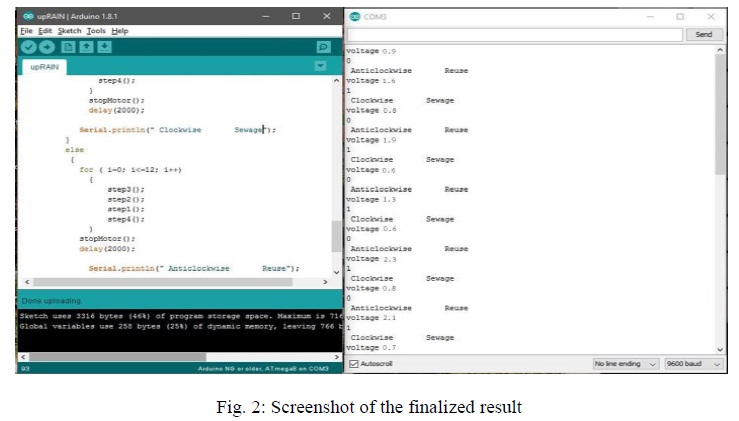





Published on Nov 30, 2023
The aim of the project is to develop an inexpensive system to conserve water. Water scarcity is the major problem that is faced all across the world. Across the world, there continues to be huge volumes of wastewater pumped directly into rivers, streams and the ocean itself. The impact of this is severe – aside from the damage to the marine environment and to fisheries it can cause, it does little to preserve water at a time when many are predicting that a global shortage is around the corner. The demand for fresh clean water delivered to our homes is ever increasing as more and more residential homes are being established. When the waste water is mixed with the waste materials such like garbage, household waste, toilets liquid and disposable things, the resulting product called sewage or waste water. Demands on water resource for households, commercial, industrial and agricultural purposes are increasing greatly.
The paper focuses on the reuse of water in houses using an electromechanical system. The proposed system comprises of pH and particulate sensor interfaced with the stepper motor that operates the electromechanical system.
In recent years, there has been advancement in the technologies and methods employed for recycling and reusing to conserve water. A method to optimize recycling of waste water that is contaminated with dispersion colorants is developed. Dispersion colorants are used for the purpose of coloring cardboard boxes that are used for packaging. This method is suitable for subsequent treatment similar to the classic urban sewage. The method of Rotational Biological Contactors that is proposed comprises of three parts, i.e., RBC tank, settling tank and disinfection tank unit. Low, medium and high concentrations were used to run the mathematical model. The water thus obtained from this process can be used for disinfection and sand filtration. A research project SiMONA that aims at building an innovative infrastructure for decision support in managing waste water networks was developed.
The hybrid network thus built using the inexpensive smart sensors and multisensory devices are responsible for monitoring process. The IoT based system for residential water recycling that was designed deals with a novel integrated system for residential water management. Based on the type of contaminants present, water collected from various sources is classified as grey water and black water. IoT, ZigBee and GSM are used for processing the data received. A novel method to reuse rain water has been introduced. It is a low cost electronic application. The pH value is monitored. If the water is within standards, it can be reused. There are many water reuse systems that have been developed with minimal treatment. In California, sub surface irrigation of gardens has been in practice for quite some years.
To create a system that is effective and considerably reduces the domestic wastage of water.
To recycle the liquid waste water that is within permissible limits.
To use recycled water for selective domestic purposes.
To increase and promote water reuse schemes.
To develop economically feasible methods.
1. The proposed work employing a pH sensor and particulate sensor that operates the Electro-mechanical System comprising of Motor and flaps for the diversion of water. The motor facilitates the opening of appropriate flaps in the system.
2. Water that is used in various areas in the house (kitchen, washbasin and bathroom) is made to flow through a common channel or a pipe.
3. The sensors that are used are programmed using the Arduino Uno board.

4. They are programmed in a way so as to detect the particles and concentration of chemicals or waste in the water and the sensing of the pH values.
5. The sensors detections influence the working of the motor.
6. The motor facilitates the movement of two valves i.e. the valve to the sewage line and the valve to the recycled water sump.
7. When the sensor senses the water and if it is within the permissible limits, the valve to recycle bin opens. Else the valve to sewage line opens and water is discarded.
8. In this method the bacterial contaminants cannot be sensed. It is a simple method for sensing water. It does not contribute to saving more than 10 – 20% of water.
9. This is applicable for new dwellings.
10. The sensors have to be tuned keeping in mind the permissible pH values to maintain the hygiene.
11. Since the water that is available for reuse is not free from harmful chemicals, precautionary measures and proper guidelines have to be defined on the methods of usage.
12. We use lead acid battery to power the motor. It should be connected to photovoltaic cells for charging. The cells, solar panels and batteries are designed with proper specifications. It has to be noted to charge the solar panels at the ratings higher than required. It should also be noted that the panels are not charged below the required ratings to avoid floating conditions and failure of the systems.
13. The pipe is not positioned straight in order to increase the time taken by the water to flow from the source to the common channel. This in turn reduces the pressure of water in the pipe. The channel through which the water flows is a 4-inch pipe.

The flowing water is tested, and if the pH values are within the permissible limits and there are no particles present, the water flows to the reuse tank as shown in the figure shown above, for the remaining conditions the motor opens the valve to the Sewage tank. When the motor rotates in the clockwise direction it indicates that the water flows to the Sewage Tank else the water flows to the Reuse tank.
The proposed model is used only for segregation of the house hold water that is being wasted. The further work that has to be taken into consideration is the chemical that has to be added in order to reduce the microbial activities that are taking place in the recycle tank, the water that is stored in the recycle must be processed so that it will be apt for used for drinking. This model has to be further developed in order to make sure that the water that is being wasted is conserved at the most.
In the present scenario, there is scarcity of fresh water resources. The Water is integrated into every aspect of our lives and it is essential to protect this valuable resource. In this proposed method water can be reused without the usage of any chemicals. By implementing this method, we can make smart utilization of water.
1. D. Sundermann, “Voice Conversion: State-of-the-Art and Future Work,” in Proc. of the DAGA , Munich, Germany, 2005
2. D. Sundermann, “A Language Resources Generation Toolbox for Speech Synthesis,” in Proc. of the AST,Maribor, Slovenia, 2004
3. B. Ramana Reddy, J. V. Sharma, “Movement based and Voice enabled Device Switching for basic needs of Physically Challenged Persons” International Journal of Science and Research (IJSR), India Online ISSN: 2319-7064, Volume 2 Issue 3, March 2013
4. Jeen-Shing Wang, and Fang-Chen Chuang .An Accelerometer-Based Digital Pen With a TrajectoryRecognition Algorithm for Handwritten Digit and Gesture Recognition IEEE Transactions on Industrial Electronics VOL. 59, NO. 7, JULY 2012.